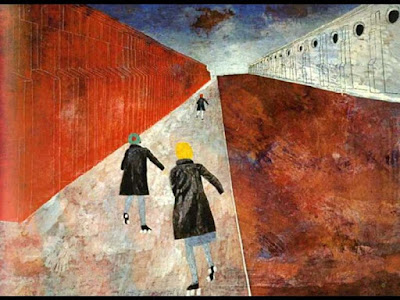The main reason is that they have essentially doubled the core paintings in the exhibit. While the Idea of North is nice, it is only a very small part of Harris's work, and these iceberg paintings are probably not actually his technically most adept work. His early work looks at a number of urban scenes, many of them in Toronto's slum "The Ward," which was located only a few blocks from the AGO (basically this was all cleared and it is where Nathan Phillips Square and City Hall are currently located). He occasionally had people in his paintings, which you would never guess from the core exhibit (even The Ice House, while nice as a composition, is devoid of people).
I can't include all the paintings (and some I'll have to go back for a clearer shot) but here are several I found interesting, and which are only on view in Toronto.
 |
| Lawren Harris, The Eaton Manufacturing Building, 1911 |
 |
| Lawren Harris, Snowfall, 1920 |
 |
| Lawren Harris, Approaching Storm, 1911 |
 |
| Lawren Harris, Street Scene, 1922 |
I don't recall ever seeing Harris work as much with light and darkness, as he does in Approaching Storm, which is a very dark canvas with only some illumination. (Not quite in Rembrandt's league, but still an interesting composition, and one that does work best when viewed in person.)
Street Scene is almost a complete departure from Harris's architectural heavy early work, though the clouds provide some continuity to the somewhat abstracted landscapes that he turned to in the 20s and 30s. I see a connection to Ben Shahn here (compare to East Twelfth St. below) or at least the urban realm that Shahn explored, and I wonder what would have happened had Harris done a bit more in this vein. I would have probably liked it, though he might not have become such a legendary figure in Canada. (Of course, as I already mentioned, few people pay much attention to his abstract work from the late 30s onward, and I don't think it is his best work either.)
 |
| Ben Shahn, East Twelfth Street, 1946 |
The exhibit then moves into 2 rooms with the core of the Steve Martin-curated exhibit. Finally, we end with a bit of a hodgepodge of other artists referring to Nathan Phillips Square (but also Chinatown) and then a video of Niagara Falls at winter (to return to the sublime). I have to be honest, the last room (and video) of the exhibit is a conceptual mess.
Either end with the sublime north (which is probably the more appropriate ending) or bookend with stronger art related to Toronto's The Ward. But not both. It doesn't make any sense at all.
I would strongly recommend bringing back the Harris painting that the AGO acquired in 2005 (and was seen in the landscapes exhibit).
 |
| Lawren Harris, Grounded Icebergs, ca. 1931 |
I liked this quite a bit, and they haven't figured out how to integrate it into the main rotation, since apparently it can't be shown as part of the Thomson Collection.
And then the AGO should get on the horn to the Art Gallery of Hamilton and ask to borrow this painting, which I've actually never even seen, since it hasn't been on display recently.
 |
| Lawren Harris, Icebergs and Mountains, Greenland, 1930 |
Anyway, that is what I would do, if I ran the zoo (sorry, the AGO).
The weird ending aside, it is definitely worth coming by to see the Harris paintings, and I'll definitely be dropping by a few more times this summer.
No comments:
Post a Comment